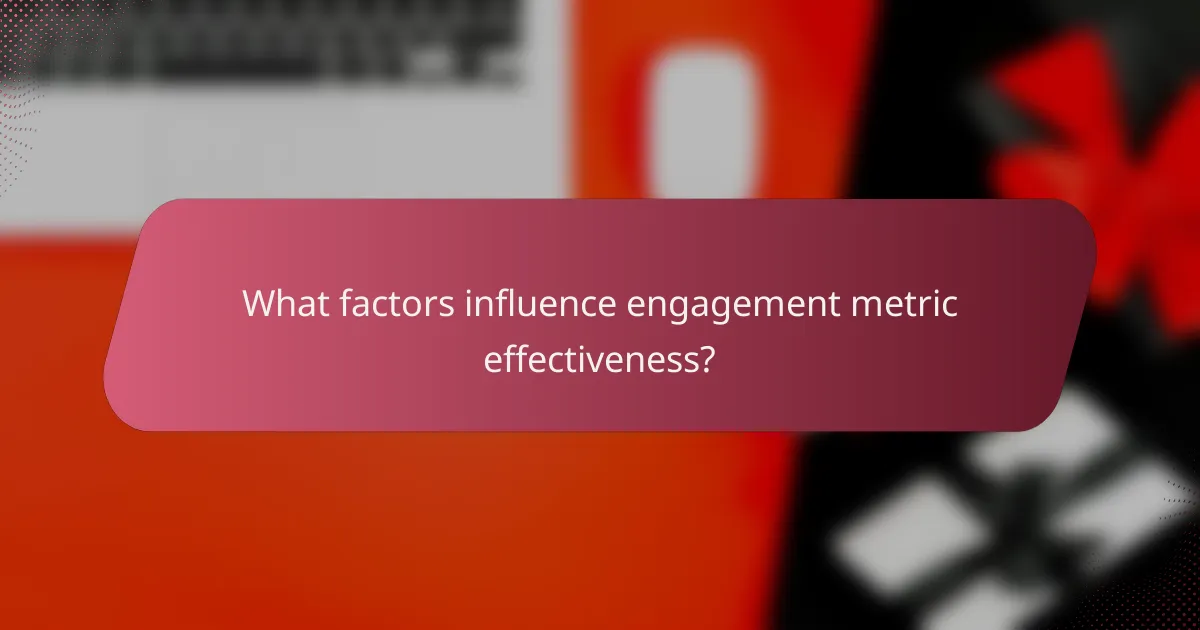Engagement metrics are essential tools for evaluating user interactions with content, offering valuable insights into behavior that can drive better business strategies. These metrics differ across various content formats, affecting audience engagement and highlighting the importance of choosing the right approach for specific goals. Additionally, factors such as audience demographics and content relevance play a crucial role in determining the effectiveness of these metrics, making it vital to understand and optimize them for enhanced performance.

What are the most effective engagement metrics?
The most effective engagement metrics are key indicators that help assess how users interact with content. These metrics provide insights into user behavior, enabling businesses to optimize their strategies for better performance and higher conversions.
Click-through rate (CTR)
Click-through rate (CTR) measures the percentage of users who click on a specific link compared to the total number of users who view a page or an email. A higher CTR indicates effective content and compelling calls to action. Generally, a CTR above 2% is considered good, but this can vary by industry.
To improve CTR, focus on creating engaging headlines and clear, actionable links. Avoid misleading titles, as they can lead to higher bounce rates and damage trust.
Conversion rate
The conversion rate is the percentage of users who complete a desired action, such as making a purchase or signing up for a newsletter. A strong conversion rate is crucial for measuring the effectiveness of marketing campaigns. Typical conversion rates range from 1% to 5%, depending on the industry and the type of offer.
To enhance conversion rates, ensure that landing pages are optimized for user experience, with clear value propositions and minimal distractions. A/B testing different elements can also help identify what resonates best with your audience.
Time on page
Time on page indicates how long users spend on a particular webpage before navigating away. Longer time on page often suggests that users find the content engaging and relevant. Aiming for an average time of 2 to 3 minutes can be a good benchmark, but this varies widely based on content type.
To increase time on page, provide high-quality, informative content that encourages users to explore further. Incorporating multimedia elements like videos and infographics can also enhance engagement.
Bounce rate
Bounce rate refers to the percentage of visitors who leave a site after viewing only one page. A high bounce rate may indicate that the landing page is not meeting user expectations. Generally, a bounce rate below 40% is ideal, while rates above 70% can signal issues.
To reduce bounce rates, ensure that your content is relevant to the audience’s search intent and that the page loads quickly. Clear navigation and engaging internal links can also encourage users to explore more pages.
Social shares
Social shares measure how often content is shared across social media platforms, reflecting its popularity and reach. High social share counts can enhance brand visibility and drive traffic. While there are no strict benchmarks, content that garners hundreds or thousands of shares is often considered successful.
To boost social shares, create shareable content that resonates with your audience, such as infographics, listicles, or compelling stories. Adding social sharing buttons and encouraging users to share can also increase visibility.

How do engagement metrics compare across formats?
Engagement metrics vary significantly across different content formats, influencing how audiences interact with each type. Understanding these differences can help in selecting the most effective format for your goals.
Video vs. text engagement
Video content typically garners higher engagement rates compared to text, as it combines visual and auditory elements that capture attention. Viewers often spend more time on video platforms, with average watch times ranging from several minutes to over an hour, depending on the content quality and relevance.
In contrast, text engagement is often measured through metrics like scroll depth and time on page, which can be lower. While articles may attract readers for shorter periods, they can provide in-depth information and are more easily indexed by search engines, enhancing discoverability.
Infographics vs. articles
Infographics tend to achieve higher engagement rates due to their visual appeal and ability to convey complex information quickly. They are often shared more frequently on social media, making them an effective tool for increasing visibility and reach.
Articles, while offering detailed insights, may require more time and effort from readers. They are beneficial for in-depth exploration of topics but may not capture attention as effectively as infographics. A balanced approach often involves using both formats to cater to different audience preferences.
Webinars vs. podcasts
Webinars generally provide higher engagement levels due to their interactive nature, allowing real-time audience participation through Q&A sessions. Participants are often more invested, leading to longer attendance times, which can range from 30 minutes to over an hour.
Podcasts, while less interactive, offer flexibility for listeners who can consume content on-the-go. Engagement is typically measured through download rates and listener retention, with successful podcasts achieving consistent listener numbers over time. Both formats can be effective, depending on the target audience’s preferences for interaction and convenience.

What factors influence engagement metric effectiveness?
Engagement metric effectiveness is influenced by several key factors, including the target audience’s demographics, the relevance of the content, and the algorithms of the platforms used. Understanding these elements can help optimize engagement strategies and improve overall performance.
Target audience demographics
Demographics such as age, gender, location, and interests play a crucial role in determining engagement metrics. For example, younger audiences may prefer video content, while older demographics might engage more with articles or infographics. Tailoring content to fit the specific characteristics of your audience can significantly enhance engagement levels.
To effectively reach your target audience, consider conducting surveys or using analytics tools to gather demographic data. This information can guide content creation and distribution strategies, ensuring that your messaging resonates with the intended viewers.
Content relevance
Content relevance directly impacts how well engagement metrics perform. Relevant content addresses the interests and needs of the audience, leading to higher interaction rates. For instance, timely topics or trending issues can capture attention and encourage sharing.
To maintain relevance, regularly update your content strategy based on audience feedback and current events. Use tools like Google Trends or social media insights to identify popular topics that align with your brand and audience preferences.
Platform algorithms
Platform algorithms determine how content is distributed and seen by users, significantly affecting engagement metrics. Each platform, whether it’s social media or search engines, has its own set of rules that prioritize certain types of content based on user behavior and preferences.
To optimize for algorithms, focus on creating high-quality, engaging content that encourages interaction, such as comments and shares. Additionally, staying informed about algorithm changes and best practices for each platform can help maintain visibility and improve engagement outcomes.

How to choose the right engagement metrics for your goals?
Selecting the right engagement metrics is crucial for measuring the success of your content and achieving your business objectives. Focus on metrics that align with your specific goals, audience preferences, and the types of content you produce.
Define business objectives
Clearly defined business objectives guide the selection of engagement metrics. Determine whether your goal is to increase brand awareness, drive sales, or enhance customer loyalty. Each objective will require different metrics for effective measurement.
For instance, if your aim is to boost sales, metrics like conversion rates and average order value are essential. Conversely, for brand awareness, focus on reach and impressions.
Identify audience preferences
Understanding your audience’s preferences is vital for choosing relevant engagement metrics. Analyze demographic data and user behavior to identify what resonates with your target audience. This insight will help you select metrics that reflect their interests and engagement levels.
For example, if your audience prefers visual content, metrics such as video views and shares may be more pertinent than text-based metrics like page views. Tailoring your metrics to audience preferences enhances the relevance of your analysis.
Assess content type
The type of content you produce significantly influences the engagement metrics you should track. Different formats, such as blogs, videos, or social media posts, have distinct engagement indicators. Recognize which metrics are most applicable to each content type.
For instance, for blog posts, metrics like time on page and bounce rate are critical, while for videos, focus on watch time and completion rates. Aligning metrics with content types ensures a more accurate assessment of effectiveness.

What are the best practices for improving engagement metrics?
Improving engagement metrics involves optimizing content, testing variations, and enhancing user experience. These practices help retain audience attention and increase interaction rates, ultimately driving better performance across digital platforms.
Optimize content for SEO
SEO optimization is crucial for improving engagement metrics as it increases visibility and attracts relevant traffic. Focus on keyword research, ensuring that your content aligns with what users are searching for. Use tools like Google Keyword Planner to identify terms with high search volumes.
Incorporate on-page SEO techniques such as meta tags, alt text for images, and internal linking to enhance discoverability. Regularly update content to keep it fresh and relevant, which can positively impact rankings and user engagement.
Utilize A/B testing
A/B testing allows you to compare two versions of content to see which performs better in terms of engagement. This method can be applied to headlines, call-to-action buttons, or even layout designs. Start with small changes and measure their impact on metrics like click-through rates or time spent on the page.
Implement tests over a sufficient duration to gather meaningful data, ideally a few weeks, depending on your traffic levels. Analyze results to make informed decisions, and avoid making assumptions without data backing your choices.
Enhance user experience
Improving user experience directly influences engagement metrics by making content more accessible and enjoyable. Focus on website speed, ensuring pages load within a few seconds, as delays can lead to higher bounce rates. Tools like Google PageSpeed Insights can help identify areas for improvement.
Design for mobile responsiveness, as a significant portion of users access content via smartphones. Simplify navigation and ensure that the layout is intuitive. Regularly gather user feedback to identify pain points and make necessary adjustments to enhance overall satisfaction.

How do engagement metrics vary by industry?
Engagement metrics differ significantly across industries, reflecting the unique ways businesses interact with their customers. For instance, retail focuses on direct sales and customer interactions, while technology companies may prioritize user activity and retention.
Retail engagement metrics
In the retail sector, engagement metrics often center around customer interactions, sales conversions, and foot traffic. Key metrics include average transaction value, customer retention rate, and in-store engagement levels, which can be measured through loyalty program participation or mobile app usage.
Retailers should consider the seasonal fluctuations in engagement, as metrics can vary widely during peak shopping times like holidays. For example, a successful campaign might see engagement rates increase by 20-30% during these periods, while off-peak times may yield lower figures.
To effectively track retail engagement, businesses can utilize tools like customer relationship management (CRM) systems and point-of-sale (POS) analytics. Regularly reviewing these metrics helps retailers identify trends and adjust strategies accordingly, ensuring they meet customer expectations and improve overall satisfaction.
